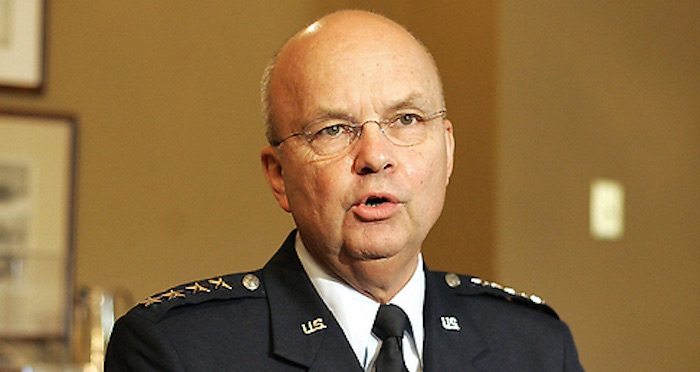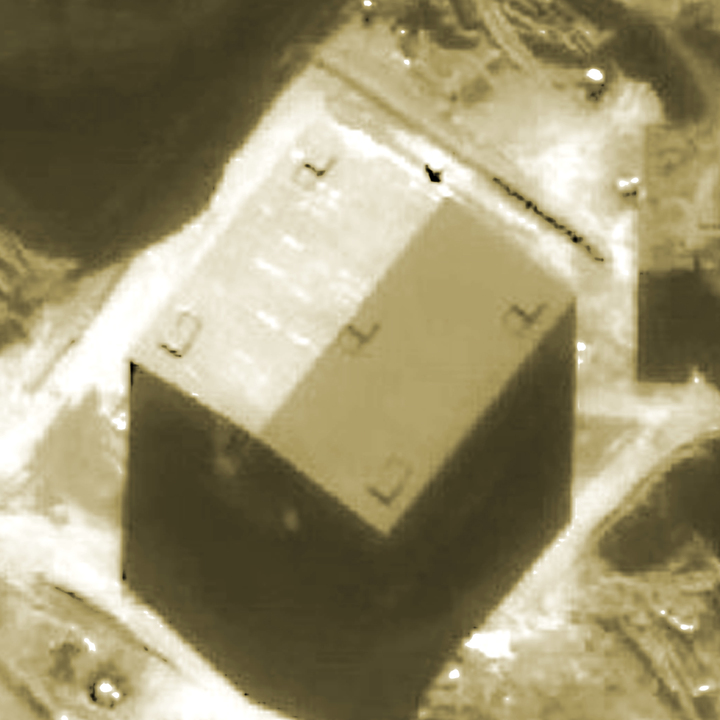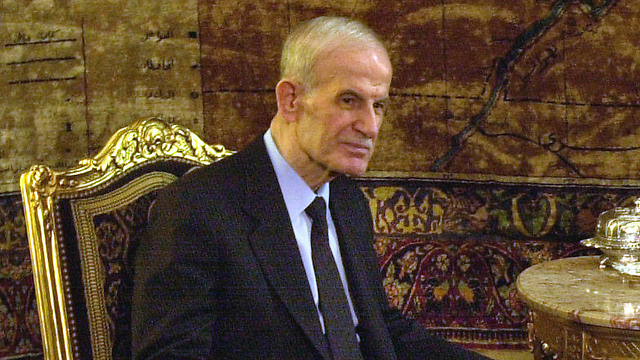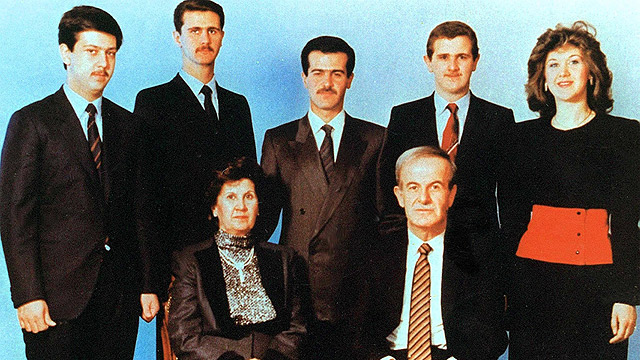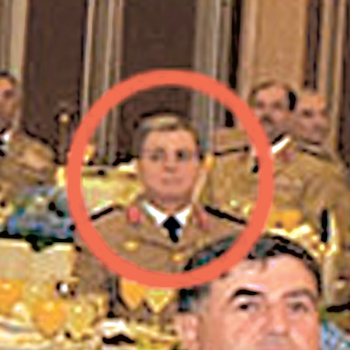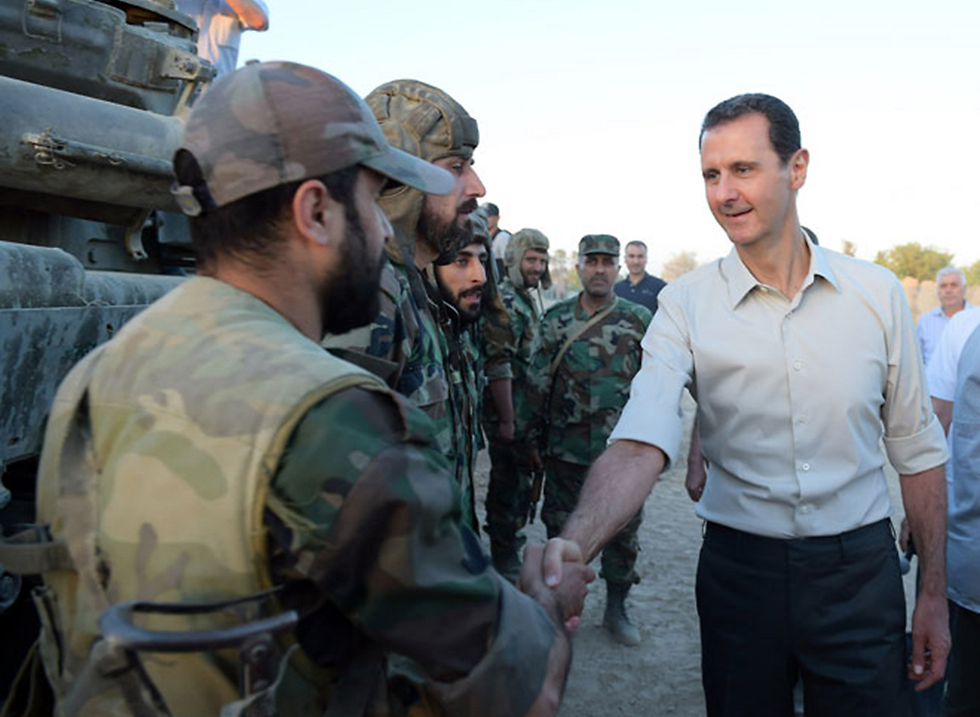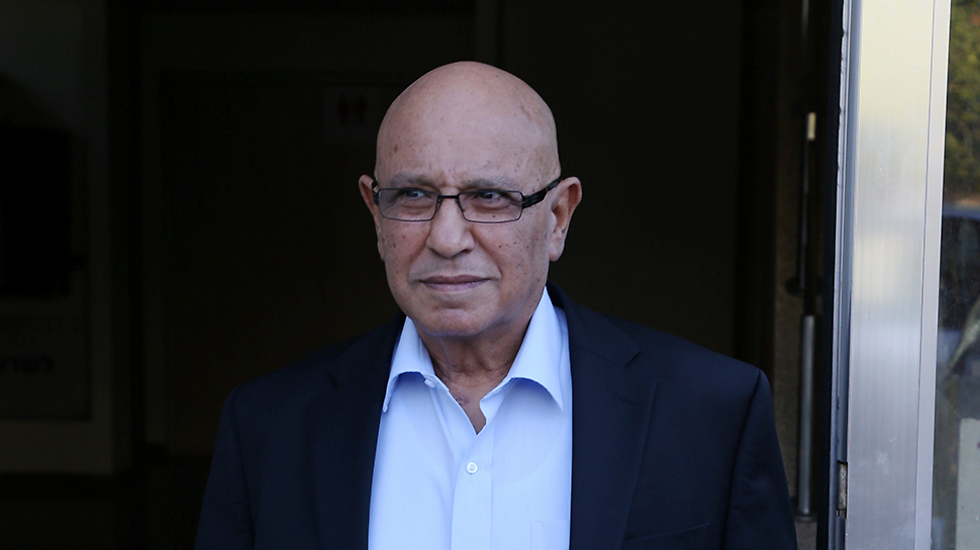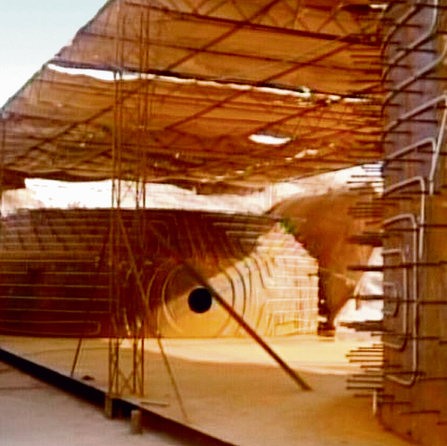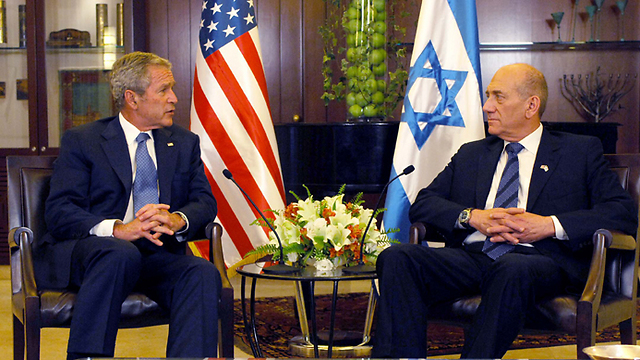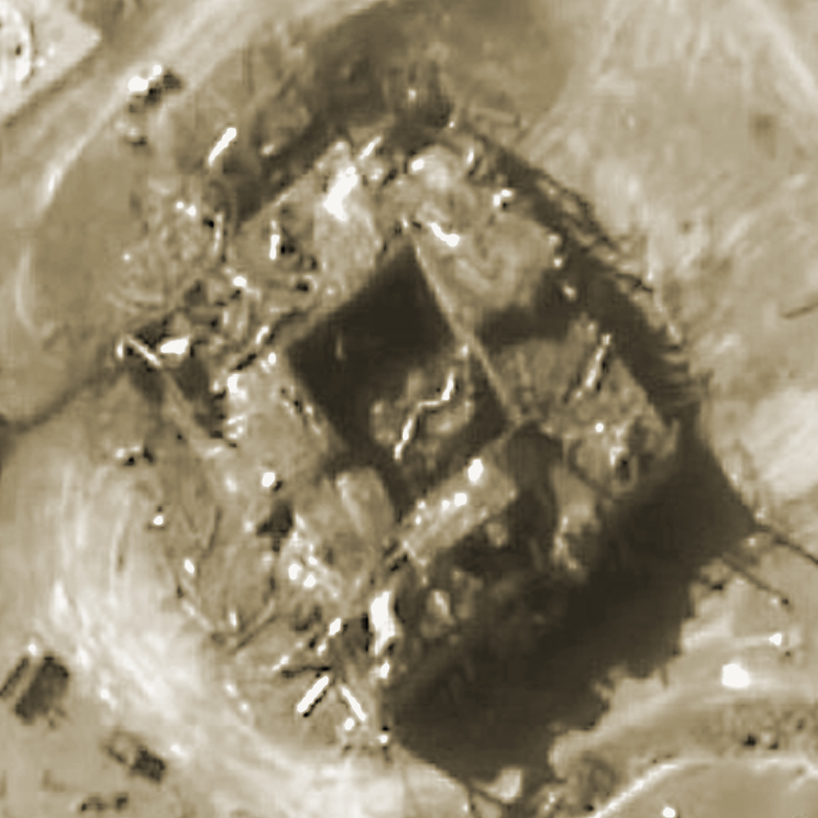Gen. Michael Hayden provides an inside look into the attack that stopped Assad’s nuclear ambitions in their tracks. From that fateful moment when Meir Dagan entered his office with photos of the reactor, through the clash between the Mossad director and the CIA’s analysts, who feared an all-out-war with Syria, to the secret meeting at Bush’s residence in which Hayden announced: ‘Mr. President, the Syrians are building a nuclear reactor, and it is part of a weapons program.’
“It was one of the most candid conversations I’ve ever had with him,” says Gen. Michael Hayden as he recounts that fateful meeting with Mossad director Meir Dagan on the seventh floor of the United States Central Intelligence Agency headquarters in Langley, Virginia.
It was in April 2007, at the office of General Hayden, the director of the CIA at the time. When Hayden with his broad smile talks about a “candid conversation,” he means one between two people who have known each other for many years and had great respect for one another. But at least in that conversation, there was total disagreement between them.
That charged conversation at Langley revolved around one question: “How can this thing, which undoubtedly endangers the peace in the region, be destroyed without starting an all-out war in the Middle East?”
“This thing” was the Syrian nuclear reactor that was secretly being built at the time in Deir ez-Zor, not far from the Euphrates River.
Several months earlier, Hayden recounts, at that very same desk, the late Mossad director showed Hayden photos of that secret site, the first the Mossad was able to obtain. Since then, the two nations’ intelligence communities have mounted a worldwide covert intelligence gathering operation in an effort to understand what exactly was happening in Deir ez-Zor and at what stage of the construction was the reactor.
The conclusion the two intelligence communities reached, according to Hayden, were more or less the same: North Korea was building a nuclear reactor in Syria that was similar to the one in its capital of Pyongyang, and this clandestine project could only have one objective: developing nuclear weapons.
But the two intelligence chiefs were of different minds regarding one question: What should their countries do with that information?
Hayden says that Meir Dagan tried to convince him to walk into the Oval Office and convince President Bush to send a squadron of B2 stealth bombers to destroy the reactor. Hayden, who was basing his position on what he heard from the CIA’s expert analysts, was sure that if the US did that, Assad would launch an all-out-war.
“In hindsight,” Hayden says, “it turns out Meir was right to think Assad would actually show restraint and not retaliate, and my analysts were wrong.”
What happened next is no secret. In September 2007, Israel mounted an airstrike on the Syrian reactor and destroyed it.
Despite the fact nine years have passed and Syria is currently being torn by a civil war, this complex operation, which remains shrouded in mystery, still ignites the imagination of journalists from across the globe, who continue publishing contradictory reports about the strike.
I met Hayden recently at his corner office, overlooking Washington, DC’s beautiful views, at Chertoff Group, one of the biggest security consultancies in the US, of which he is a partner.
The meeting was in honor of the release of his autobiography, “Playing to the Edge,” which includes a chapter on the discovery and bombing of the reactor. Hayden agreed to share his fascinating testimony of the Syrian reactor affair—from the moment Dagan showed up in his office with the implicating photos, through the arguments at the top echelons of Israeli and American leaderships, to the decisive meeting at the White House, the attack on the reactor, and the series of events that followed it both in the Middle East and in Washington.
Hayden recounted every moment of one of the most dramatic events of that time, with President Bush and Prime Minister Olmert at the helm and Hayden and Dagan as the senior intelligence officers at their side.
On the agenda: Syria, an enemy state to Israel with close ties to Iran and Hezbollah, which was working to obtain a nuclear bomb that would change the balance of power in the Middle East.
The stakes: Syria’s missile arsenal includes chemical warheads that cover the entire Israeli territory. American analysts warned that bombing this reactor could lead to a war whose outcome was unknown. On the other hand, Dagan makes it absolutely clear: “Israel cannot accept a situation in which an enemy state is armed with nuclear weapons.”
And now, a fateful decision had to be made that could alter the course of history.
The smoking gun, or: The Syrian ‘Godfather’ allegory
In 1991, then-Syrian President Hafez Assad made a military acquisition alliance with the dictatorial regime in North Korea. He purchased missiles, as well as a lot of knowledge on how to produce more advanced missiles. He viewed this arsenal as a counterbalance to nuclear weapons he believed Israel had. For many years, the Israeli intelligence community believed that the Syrian leadership thought its chemical weapons were enough to maintain the balance of power against Israel and that Damascus was not trying to obtain nuclear weapons.
But what Israel did not know was that near the end of the 1990s, something changed for the Syrian president. It might have had something to do with the tragedy that befell him when his beloved elder son and heir, Bassel, was killed in a car accident. Since his second son, Maher, was considered hot-headed (if not worse than that), Assad senior was left with only one option for heir: His third son, Bashar, who was in London at the time, doing his postgraduate degree in ophthalmology.
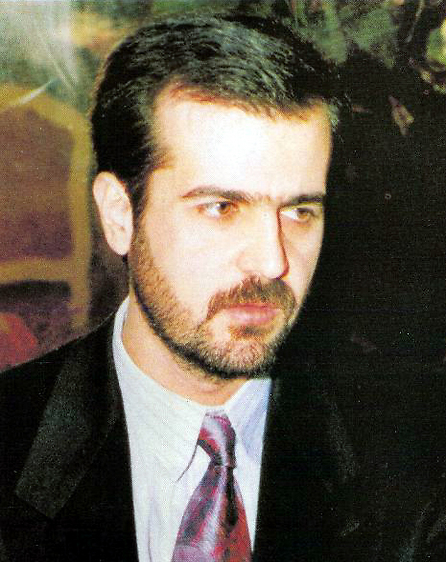 Bassel Assad, the heir apparent who was killed in a car accident
Bassel Assad, the heir apparent who was killed in a car accident
Seen as the more absent-minded, timid daydreamer among his brothers, Bashar was nevertheless summoned from London by his father Hafez who, until his death in June 2000, trained his son to be the next leader of Syria.
At the time—it’s unclear on whose initiative—the possibility arose for Assad senior to buy a nuclear reactor from the North Koreans that would create military-grade plutonium to be used in building a nuclear bomb. Assad eventually signed a contract with North Korea to build that reactor, but construction was done at a relatively slow pace.
“It’s quite possible,” Hayden says, “that the reason he started this project was because he was worried his son was too weak and not really fit to lead Syria after his death, and he sought to leave Bashar with a powerful weapon that would ensure his survival.”
Bashar Assad tied his fate to Iran and Hezbollah. His representative in this alliance, the “Radical Front” as it is referred to by the IDF’s Military Intelligence Directorate’s Research Division, was a mysterious man called Gen. Muhammad Suleiman. He was so mysterious that his name and appearance remained a secret until his death, despite the fact he was a general. Suleiman was an engineering graduate of Damascus University, underwent countless technology and military training courses in the Soviet Union, and was a man whose great talent was surpassed only by his extremism.
The ties to Iran and Hezbollah, Syria’s involvement in terror activity and in drug trade, and its continued presence in Lebanon among other reasons, have all led the American intelligence community to underestimate the new Syrian president.
In the argument that would take place several years later between Hayden and Dagan over what should be done about the Syrian reactor, the CIA director told his Mossad counterpart that the Assad family reminded him of the Corleone family from Mario Puzo’s The Godfather.
“There is no doubt the Assads, along with the Makhloufs who are tied to them in bonds of marriage and partnerships, were just as busy with crime and committing particularly cruel acts as they were with ruling over Syria,” Hayden told Dagan.
Just like in The Godfather, the Assad family also lost its older son, the heir apparent. In The Godfather, that son is Sonny, who in the movie is murdered by assassins.
“But when Sonny was rubbed out, the Don had the gifted Michael to replace him. When Basel Assad was killed in an accident, Hafez had to settle for the one who represented Fredo, the weak and lazy brother, the one no one had ever imagined would ever get to a position of power—Bashar.”
Assad junior was known in the CIA as a “serial miscalculator.” Hayden reveals that “we tried to cooperate with him against the terrorists who were fighting us in Iraq, but almost without success. The Syrians looked the other way when this activity crossed into their territory.”
Assad junior may have been a failed serial gambler, but on one thing he took no chances: His fear of just how much the Mossad and the Israeli Military Intelligence Directorate knew about what was going on inside his country. Bashar became truly obsessed with his loathing—and admiration—to the Israeli intelligence community. He was convinced that any phone call or digital message in Syria was being intercepted by Israeli intelligence. “He truly believed that every time Mustafa was calling Mohammad, Moishe’le was listening in,” says a senior intelligence officer in the IDF’s elite 8200 unit with a smile.
To evade the Israeli intelligence community’s watchful eye, General Suleiman carried out his special clandestine missions through a bureaucratic and operational body, which was completely separated and isolated from the rest of the Syrian defense establishment. Assad authorized Suleiman to keep knowledge of the existence and operations of this body even from the most senior military figures in Syria, including the army’s chief of staff and the defense minister. When Israel discovered this activity—quite late in the game—officials in the Military Intelligence Directorate would dub it “General Suleiman’s Shadow Army.”
Suleiman instructed his men to send any important message, any plan, only in envelops sealed with wax, using a network of messengers on motorcycles. It worked. Suleiman’s operations were kept completely hidden from the Israeli intelligence community despite the great resources invested to ensure it missed nothing important.
General Suleiman kept the greatest secret of all hidden in Deir ez-Zor, in northeastern Syria. There, at an isolated and faraway area, construction was underway on the nuclear reactor the Syrians bought from North Korea with the help of Iranian funds (intelligence officials both in Israel and the US are still split on whether or not Iran knew what the money it was giving Syria was being used for).
Such a reactor could produce plutonium for a nuclear bomb, which the young Assad believed would help Syria reach strategic equality with Israel. The nuclear reactor project was so clandestine and compartmentalized that even Syrian Chief of Staff Ali Habib Mahmud didn’t know anything about it. When he heard that Israel attacked a facility in the area, he thought they had got the wrong address.
For many years, Israel had no idea what was going on in the isolated compound in Deir ez-Zor. The fact Israel didn’t know the reactor was being built “is a failure akin to that of the Yom Kippur War (the surprise attack in October 1973) for the Israeli intelligence community,” one of the former intelligence heads told me.
Hayden says that already in 2001, the CIA began to gather scattered, unverified and ambiguous information about nuclear ties between Syria and North Korea. It will be years before the real meaning of this information comes to light. Only after Dagan came to Hayden with the photos of the reactor.
In 2004, according to Hayden’s notes, the National Geospatial Intelligence Agency—an agency in the US Defense Department whose primary mission is collecting, analyzing, and distributing geospatial intelligence—discovered the reactor site and marked it as “enigmatic,” but “we couldn’t exactly tell what it was,” Hayden explains.
That year, the US National Security Agency intercepted a series of transmissions from the Deir ez-Zor area to North Korea, in a North Korean code the CIA was unable to break.
The turning point was when the Mossad was able to obtain photographs that the head of the Atomic Energy Commission of Syria, Ibrahim Othman, took with him on a trip to Europe. The German weekly Der Spiegel claimed the Mossad managed to get the photos from him in London, while the New Yorker reported it happened in Vienna.
Either way, the knowledge that Syria was at an advanced stage of its nuclear project and that Israel was oblivious to it hit the Israeli intelligence community hard.
“Meir came to me with this material (the photos taken from Othman’s laptop),” recalled Ehud Olmert, “and it was like an earthquake. I realized that from now on everything would be different.”
The options on the table, or: Dagan’s brilliant trick
According to few reports, the IDF’s Military Intelligence Directorate and the Mossad launched a wide-scale operation to gather intelligence about the reactor, Suleiman, and his “Shadow Army.”
A report by David Makovsky in the New Yorker claimed that in June 2007, Olmert instructed to dispatch a special operations unit to within a mile of the reactor to gather soil, water and vegetation samples that would help determine whether the reactor had already gone hot and to conduct observations of the security at the facility.
At the same time, Olmert sent Dagan, along with his chief of staff Yoram Turbowicz and political advisor Shalom Turgemen, to Washington to brief Hayden and the White House.
By this time, when he rode the elevator up to the seventh floor of CIA HQ at Langley, he was already a familiar—and welcome—guest.
Dagan first met with Hayden in 2003, when the latter was leading the NSA. “He was to the point, an intelligence officer in every bone in his body, and he listened to what I proposed,” Dagan said. The result was very impressive and initiated an era of deep cooperation between the two agencies.
Thus it came to pass that Dagan, who lacked the niceties and polish of the American elites, and whose English was pretty basic, succeeded in establishing the closest ever mutual trust between the top echelons of the intelligence agencies of the two countries.
“I never felt being manipulated,” Hayden says of Dagan. “No, no. He was representing Israel, and he was representing Mossad, and he was representing Israeli policy. But I never had the impression that he was trying to mislead me for Israeli advantage.”
Dagan, according to Hayden, was “straightforward, plain spoken, bluntly honest, unpretentious, sincere and very knowledgeable.”
The former CIA chief also described the relationship between the two intelligence agencies: “We’re big, we’re rich, technologically sophisticated, and we’re global,” while the Israelis are “small, focused, culturally and linguistically smart and relevant to the targets (Jihadist terrorism and attempts by Middle Eastern countries to develop weapons of mass destruction).”
When Hayden was named head of the CIA in 2005, he further deepened collaboration with the Mossad. Every time that Dagan came to visit, he brought with him sensitive information and suggestions—some of them quite imaginative—for joint operations.
But at that April meeting, not even the experienced Hayden anticipated the bombshell. “Dagan sat down, opened his briefcase and took out color copies of the pictures of the reactor at Deir ez-Zor.”
For an hour, Dagan “walked me through the intelligence” and wanted to know whether the CIA experts agreed with the Mossad’s analysis of the intelligence material.
Dagan, Hayden says, realized that with all due respect for the Mossad’s capabilities in Syria, his agency had almost no information about what was happening at the other end of the nuclear deal—North Korea. So he asked Hayden to take the information he had brought “and plug it into the CIA’s broader knowledge of North Korea.”
Incidentally, the fact Dagan was sharing the Israeli intelligence’s top secret with his American colleague surprised the CIA director, considering the “less-than-glamorous record of the American administration with keeping secrets,” Hayden says.
During the interview, Hayden wonders aloud whether that generosity might have had another reason, which Dagan did not state specifically. “He wanted me to influence American policy on this matter,” Hayden offers.
In other words, Dagan wanted the American intelligence community to tell the decision-makers at the White House that they share Israel’s factual assessment of the situation, which could have an effect on the kind of measures Israel was going to ask the US to take in light of this monumental development.
After that meeting, Dagan left the CIA headquarters and headed to the White House with Turbowicz and Turgemen to apprise Stephen Hadley, the then-US National Security Council chief, of the situation.
Back at Langley, Hayden was left with a group of his closest senior aides. “Meir never told me where they got the photos from,” Hayden recounts. “Our guess was that they downloaded them from the computer of a careless Syrian scientist. But none of that really mattered. What Meir showed me was pretty convincing. The question was only whether this was authentic material or a form of very sophisticated forgery.”
The first task Hayden gave his experts was to ascertain whether the photos had been doctored. Hayden did not suspect the Mossad of doctoring the photos, but because he did not know where Israel had obtained the photos from, he instructed his experts to make every effort to determine whether the photos were real.
Hayden’s experts had doubts concerning one of the photos Dagan had brought them. They zoomed in to closely examine the side of one of the trucks in the photo, and thought the writing on it might have been photoshopped. But the rest of the photos passed the strict examination and were found to be authentic. The CIA’s photo lab even constructed three-dimensional computerized models of the facility in Deir ez-Zor based on the photos and compared them to other photos. Everything matched exactly.
The day after his meeting with Dagan, Hayden was called to the White House for an urgent meeting. President Bush had already received a general update from Hadley on the matter. While the gathered officials waited for Bush to join them, Hayden turned to Vice President Dick Cheney, who has been claiming Syrian was trying to obtain nuclear weapons for a long time, and whispered in his ear: “You were right all along, Mr. Vice President.”
Hayden presented Bush with the photos he got from Dagan. “That was the very last thing he needed,” Hayden recounts, “having to take action in a region where any action could spark a war, with an ally that has the ability and the desire to work alone.”
President Bush already learned a sobering lesson when US intelligence agencies had told him that Saddam Hussein had weapons of mass destruction, leading him into a long, bloody war in Iraq. He summed up the meeting with two clear-cut but rather contradictory orders: “Number one, be sure. Number two, this can’t leak.”
Hayden went back to Langley wondering how to corroborate the Israeli information without spreading the word about. “To be sure, you want to get more people involved, but that increases the risks of spilling the secret.”
Hayden joked with his close aides that if Assad learned that his reactor had been found out and that the Americans and Israelis were investigating the matter, he’d immediately get rid of all of the implicating evidence “and claim that this was a daycare center.” After all, “the building itself,” Hayden says, “looked from the air like a Walmart store.”
But the head of the CIA was well aware that if the information does leak, the joke would be at his expense. In an attempt to reconcile the president’s two orders, Hayden formed an inquiry team, in what was later described in a classified cable from Condoleezza Rice as “an intensive, months-long effort to confirm and corroborate the information Israel provided us on the reactor and to gather more details from our own sources and methods.”
The conclusions of the team—which included experts from the Pentagon, the CIA and the NSA—were deeply troubling: “the facility is in fact a nuclear reactor of the same type North Korea built indigenously at its Yongbyon nuclear facility … We have good reason to believe this reactor was not intended for peaceful purposes.”
Hayden says he had formed a “red team” that was instructed to “build an alternative case as to why it’s not a nuclear reactor.” The team, made up of analysts who had not yet been “read in” on the intelligence regarding the Syrian reactor, received all of the data and intelligence, and after close examination and thorough investigation came back with the following conclusion: “If it isn’t a nuclear reactor, it must be a fake nuclear reactor.” In other words: It’s a Syrian plot to make it appear as if they were covertly building a nuclear reactor. Of course, such a thing would be highly unlikely, and so the red team essentially confirmed the conclusion that what Syria was building in Deir ez-Zor was indeed a nuclear reactor.
In a meeting between Olmert and Bush, recounted by the president in his autobiography, the Israeli prime minister asked the Americans to bomb the Syrian reactor. When he returned home, Olmert reported to a small group in his cabinet that it was his understanding that Bush was going to bomb the reactor.
But during that time, a heated argument took place between Hayden and his analysts and Dagan and his men. The background to that argument was the murder of Lebanese Prime Minister Rafic Hariri a year and a half earlier by Hezbollah assassins who were sent by Syria. The outcry from the international community and the immense pressure that Bush and then-French President Jacques Chirac put on Assad have led to the withdrawal of Syrian forces from Lebanon.
“Assad could not stand another embarrassment after the (2005) withdrawal from Lebanon,” Hayden said. “Out of weakness, he would have to show his strength and retaliate with war.”
Dagan took the exact opposite view: “You had to look at it from Assad’s point of view,” he said. “On the one hand, he had always wanted to reach strategic equality with Israel, and therefore get his hands on nuclear weapons. On the other hand, Bashar Assad always preferred not to confront us directly. Furthermore, if he went to war after the bombing, it would expose the existence of the nuclear installation—that he had built an atomic facility in violation of his signature on the NPT—which even the Russians, his allies, don’t know about, and for sure would not be happy to know of it. If we were to attack covertly, and keep it totally under wraps without publicizing it and embarrassing him, Assad would not do anything.”
Dagan’s recommendation was to bomb posthaste, before the reactor becomes active and its destruction could cause radioactive pollution. Hayden says that Dagan was very firm in his stance: “Israel cannot accept a situation in which an enemy state is armed with nuclear weapons.”
On the other hand, if war with Syria had broken out, it is safe to assume that while it would have ended in Israel’s victory, this win would be costly: Thousands of victims and a significant change of the political situation in the region.
The dark prophecies of Hayden’s analysts led to intense consultations at a series of forums in the American intelligence community, at the National Security Council, and at the White House.
“It was clear to us that a strictly diplomatic approach would not lead anywhere,” Hayden says.
Theoretically, the Americans could make the existence of the reactor public and hand over the information they had gathered to the International Atomic Energy Agency (IAEA). But the Americans realized that this would eventually lead to endless stalling by Assad, who would repeatedly postpone visits by the IAEA’s inspectors to the reactor. The damage would be enormous: The entire world would realize the US was sitting on this information and failed to act decisively. Meanwhile, Assad would hide the evidence so “eventually, we would have looked completely pathetic,” Hayden asserts.
Another possibility that was raised was a commando operation of a Delta Force—the Navy SEALs—or another American Special Forces unit. The advantage of such an operation is, of course, that it is low profile, doesn’t point an accusatory finger at anyone, and might stop Syria from launching an all-out-war in retaliation. The downside is that Syria will probably blame the United States regardless, and that “it wasn’t clear whether the force would be able to carry enough explosives to blow up the entire facility. And, of course,” Hayden adds, “the danger the SEALs would be caught.”
A third operation on the table: Bombarding the facility. “B2 stealth bombers that would take off from one of our bases in the Mediterranean or the Persian Gulf could reach the facility and destroy it,” Hayden explains. “Syria’s aerial defense was respectable, but nothing we couldn’t handle.”
But the American intelligence analysts believed that such a public attack risks an all-out-war breaking out. “The more we thought about it, the more we reached the conclusion a hybrid option was preferable: Diplomatic action that entails an ultimatum of military action,” Hayden says.
The American intelligence community’s recommendation was “To démarche the Syrians with a threat,” to publish the incriminating photos in a special White House statement, and give the Syrians only a few days or weeks to dismantle the installation and to allow IAEA inspectors access to the site to ascertain that this had been done. If the Syrians refused—immediately follow up with an attack on the reactor.
“The weak point of this solution was that it gave Assad enough time to gather some of the 7,000 American citizens in Syria and take them hostage.”
With these options, Hayden went into the boss’s office. It was time to make a decision.
Meeting in the Yellow Oval Room, or: ‘No Core, No War’
The crucial meeting took place at the White House. The matter was so secret that the meeting wasn’t held in the West Wing, but on the second floor of the White House’s residential area—in the Yellow Oval Room—to keep it out of the president’s public schedule. The meeting included President Bush, his vice president, the defense and state secretaries, the Chairman of the Joint Chiefs of Staff, the national security adviser, the heads of the American intelligence community, and others.
As the guests sank into the comfortable arm chairs, the staff served them iced tea and then left. Stephen Hadley turned to Hayden and asked him for the latest intelligence update.
“Mr. President,” Hayden began, “I have an update that contains four main points. The first: it is a nuclear reactor; the second: the Syrians and North Koreans have been cooperating on nuclear matters for about a decade; the third: the North Koreans are the ones who built the facility in Deir ez-Zor; and the forth: the facility is part of a (greater) plan to produce nuclear weapon.
“I imagined that after I said those things, everyone would think about the Iraq affair,” Hayden remembers. That is why he quickly explained why the Syria case was different and why this time there was a very high degree of certainty that the facility is in fact a nuclear reactor.
Hayden then explained that the nuclear reactor was “an exact copy of the reactor in Yongbyon and that the Koreans were the only ones to build these reactors since they purloined the designs from the British in the 1960s.”
At this point Hayden paused for a moment, allowing the gathered officials to take a deep breath, and continued with a statement just as dramatic: “But Mr. President, I was unable to locate the other parts of the Syrian nuclear weapon program: Not the reprocessing facility (chemically separating and recovering fissionable plutonium from irradiated nuclear fuel); nor the “weapons group” (of scientists and engineers building the bomb itself and its explosive mechanism). Therefore, Mr. President, there is only a low degree of certainty regarding these parts.”
During the silence that followed, then-Secretary of State Condoleezza Rice said she wished she had such intelligence officers several years earlier, referring of course to the search for the Iraqi WMDs that were never found. Rice knew the danger posed by the existence of a nuclear reactor, but objected to an American attack against it. Vice President Cheney disagreed, arguing that the US must attack to send out a strong message to Syria, North Korea and Iran—that the United States would not tolerate such behavior.
Hayden said that one thing was clear to him, “that we kind of used up all of our preemptive attack chips. And besides, we stuck to the mantra that: No Core, No War (referring to an active nuclear core). I could not say with certainty that the Syrians didn’t have a weapons group or a reprocessing facility but neither I nor the Israelis had any proof those exist.”
President Bush, who was deeply entangled in two wars against Muslim nations, concluded the discussion with: “What Mike (Hayden) just told me is this is not imminent danger, and therefore, we will not do this.”
The option that was then raised—and was accepted by most of the officials present—was making an ultimatum to the Syrians. But the implementation of this plan depended on the agreement of the Israelis, who provided the US with the photos and information, to make this knowledge public. But Dagan would in no way allow that.
Despite reaching a dead end, Hayden remembers that “I was pretty comfortable that if we didn’t strike the Syrian reactor, Israel would.”
Olmert, President Bush reveals in his memoir, was bitterly disappointed by the American decision not to strike. Many in Israel saw the American refusal to take military action as a sign that the US was not willing to take too great a risk upon itself to protect Israel, especially in the era that followed the invasions of Iraq and Afghanistan.
“We can only rely on ourselves,” the Israelis said during internal discussions.
The strike
On the night between September 6 and 7, 2007, Israel Air Force warplanes bombed and completely destroyed the nuclear reactor under construction in Deir ez-Zor.
The Syrians suffered huge embarrassment as it became known that they were advancing a project that blatantly contradicted the Non-Proliferation Treaty they signed.
The great victor of this operation was Dagan, whose organization was the one to bring the information that exposed the Syrian project and also the one “who truly understood President Assad more than anyone else,” as Hayden put it.
At first, Syria refused to give the IAEA inspectors access the site of the bombed reactor. When it finally consented, following immense international pressure, to allow the inspectors to visit the site, it was months later, after General Suleiman and his men have had time to clear the site and remove any implicating evidence of nuclear development. Despite this, the inspectors found evidence of uranium and graphite and concluded that the site bore features resembling an undeclared nuclear reactor.
Later, the UN nuclear watchdog asked to send its inspectors to three other sites in Syria that were suspected to be part of the nuclear project, but the Syrians refused. On June 9, 2011, the agency announced that Syria failed to declare the construction of a nuclear reactor and that it was in non-compliance with the Nuclear Non-Proliferation Treaty it signed.
Meanwhile, General Suleiman was furious. Within a few months, he lost both Imad Mughniyah, his colleague and close friend, and his life’s work—the nuclear reactor in Deir ez-Zor.
According to documents obtained by Wikileaks, Syrian’s mobile missile systems were on high alert following the strike, but Bashar Assad decided not to pull the trigger. This kind of behavior “requires self-discipline,” Prime Minister Olmert will later tell the US House Minority Leader John Boehner, “Assad is not stupid at all.”
Olmert had a different opinion on Suleiman. “Suleiman was a piece of shit, with extraordinary organizational and logistical abilities,” he said.
In April 2008, the CIA’s analysts reached the conclusion that Assad was not going to war over the strike on the reactor and that there was no longer a need to keep the matter a secret. They could use the material gathered for other purposes. At the time, there was a heated argument in the American administration on whether to sign yet another nuclear disarmament deal with North Korea, the likes of which it had already violated several times in the past.
Israel, Hayden remembers with a sigh, fiercely objected to making the photos from the Syrian reactor public, but the CIA chief decided differently.
“We needed to make this (the Syrian reactor affair) more public because we were about to enter into an agreement with North Korea, that had been guilty of the greatest proliferation crime in history. We had to inform the Congress,” he remembers.
The CIA even prepared a video about the discovery and bombing of the Syrian reactor. Michael Hayden, along with another senior intelligence official, presented it to the Senate’s Intelligence Committee and to a group of American journalists during a briefing. The discovery of the reactor was an impressive triumph of intelligence, and the agency was happy to be able to present a victory.
To “add a dimension of drama” and tie Damascus’s shadow operative to those in Pyongyang, the CIA also added a photo they obtained from their own clandestine sources—General Suleiman with North Korea’s nuclear chiefs—and included many details about the Syrian general, his influence and power.
Except that Suleiman was not long for this world. In August 2008, the head of Syria’s “Shadow Army” was assassinated while having dinner at his summer home in the coastal city of Tartus in Syria.
According to US cables made public by Wikileaks, the IDF’s Special Forces naval commando unit Shayetet 13 was behind that assassination.

